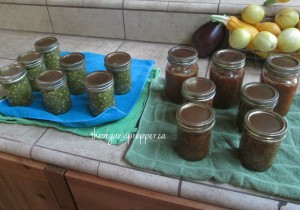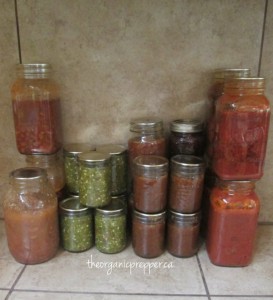
We’ve all got foods that can help lift our spirits or give us comfort when we’re having a bad day. So to me it just makes sense to have some of them stocked for a time when things have taken a turn for the worse. I realize that different people will find comfort in different kinds of food, so I tried to think of as many types of foods that could be considered “comfort foods” (and drinks) that have a decent shelf life.
Because manufacturers use “best by”, “sell by” and expiration dates to generate more business, grocery items do not actually go bad when they reach their expiration dates. Companies don’t cater to prepper’s who buy for long term storage. They have not put any money into figuring out how long their product can be stored. Because of this, the guidelines below are just that and should be looked at as a general rule of thumb and not something hard and fast.
How and where items are stored play a very large part in how long they will remain good. Keep in mind the enemies of food storage; air, moisture, pests, light and heat. Food should be kept at or below 70 degrees. Warmer temps will degrade food quicker. Keep food in a dry place. If you store food in an area with water pipes, I suggest keeping food in paper or cardboard in plastic totes. Keep food out of sunlight. One other enemy of food storage, which is more of a danger to comfort foods; a sweet tooth. To keep the “Not Me Ghost” out of your stock of comfort foods, you could label them as something less enticing.
Many of these products are sold in paper or cardboard materials, which are not air tight and not ideal for long term storage. You would most likely be able to extend the shelf life if you repackage them in Mylar bags with oxygen absorbers.
Beverages
Dry Drink Mixes Two years
These would be items such as Kool Aid, Gatorade, Lemon Aid, Tang, hot cocoa and so on.
Alcohol Many years to indefinite
In the apocalypse, one might really need a stiff drink at the end of the day. Alcohol lasts for a very long time. If left unopened, in a cool dark place, it could have an indefinite shelf life.
Tea Two Years
Loose tea, instant or tea bags, tea will remain fresh for roughly two years. It would be safe to drink after that, but might not taste as good.
Coffee It really depends
I’m only going to cover unopened coffee.
Ground Coffee 3-6 months past expiration date in the pantry, 1-2 years in the freezer.
Whole Coffee Beans 6-9 months past expiration date, 2-3 years in the freezer.
Instant Coffee I have seen from 2-20 years given in the pantry and indefinite in the freezer
Green Coffee Beans These are not yet roasted, and since the bean hasn’t been cracked the shelf life is extended. Camping Survival carries green coffee beans stored in a #10 and claims that because they are devoid of oxygen, that they have a 20 year shelf life.
Pop/soda It depends
Regular pop/soda will last for a very long time. Diet pop/soda goes bad not long after the expiration date.
Food
Baked Goods It Depends
Many comfort foods are baked, so here are some common baking ingredients. Many of these can attract bugs. I recommend you store them in Mylar bags with oxygen absorbers. This will keep them safe from all of the food storage enemies.
Whole Wheat Flour Varies
Flour won’t keep long unless in the fridge or freezer. Shelf life in the fridge is 6-8 months and 1-2 years in the freezer.
All-Purpose Flour Varies
All-purpose flour can be stored for 6-8 months in the pantry, 1 year in the fridge and 1-2 years in the freezer.
Wheat Berries Very Long
Wheat berries are ground into flour. Because the husk has not been cracked, the storage life is greatly lengthened when stored in Mylar with oxygen absorbers.
Powdered Egg 5-10+
Powdered egg is often freeze dried and, like many freeze dried foods, the shelf life is very increased.
Powdered Milk Depends
Powdered Milk will last a week or so once opened. If left sealed in the pantry 5-10 years is possible.
Cornstarch Indefinite
Baking Soda Indefinite
Sugar Indefinite
Baking Powder 6-18 months
It is suggested to use it within 6-12 months after purchase. However, it may store for 18 months in a cool dry area.
Coco 1-2 years
Opened coco will last for a year or so, unopened 2 years.
Other types of foods
Nuts 1 Month to 2 years
The oil in nuts is what causes them to go rancid. Most nuts will be good for 2-9 months after the expiration date when stored in the pantry, 1 year if stored in the fridge and 2 years in the freezer.
Candy It really depends
There are many types candy, so there is no set answer. If it contains nuts, it obviously has a shorter lifespan. If it is a gummy type of candy, it will probably harden, but should be safe for years. Hard candy has the longest shelf life. M&M’s will last 1-1.5 years due to the candy coating.
Chocolate Months to years
Items that contain just chocolate, like chocolate chips, Hershey’s Kisses and candy bars only containing chocolate have a varying shelf life. The lighter the chocolate, the shorter that is. I found the following on the Hershey’s Product FAQ
Q. How should I store chocolate?
A. Solid chocolate products will maintain their quality if well wrapped and stored in a cool, dry place (55-60°F). While refrigerated chocolate is certainly safe to use, we don’t recommend it. Chocolate kept in the refrigerator may “sweat” when brought to room temperature and may not melt properly. Cocoa is considered a non-perishable item which should maintain quality if stored at room temperature in a tightly sealed container.
Chocolate may turn white. This is called “blooming”. The chocolate is still perfectly edible. Here is what Hershey’s has to say in the FAQ.
Q. My chocolate sometimes turns tan or white. What causes this?
A. Chocolate contains cocoa butter, a vegetable fat that is sensitive to heat and humidity. Temperatures above 75°F will cause chocolate to melt. The cocoa butter can rise to the surface and form a discoloration called “cocoa butter bloom.” Condensation on milk or semi-sweet chocolate may cause the sugar to dissolve and rise to the surface as “sugar bloom.” Chocolate that has “bloomed” is certainly safe to use, but flavor loss and texture changes may be noticed.
Powdered Jell-O Nearly indefinite (Maybe)
Most of the info I could find is from sites that are not taking into consideration storing long term. But I believe as long as you’re storing the varieties that have sugar instead of artificial sweeteners, these should store for a very long time.
Powdered Pudding Nearly indefinite (Maybe)
Most of the info I could find is from sites that are not considering storing long term. But I believe, as long as you’re storing the varieties that have sugar instead of artificial sweeteners, these should store for a very long time.
Honey Indefinite
Honey can harden, but will turn to liquid when heated, and will last forever.
Various Syrups Indefinitely
Maple Syrup and molasses can last a very, very long time and often do not require refrigeration.
Jams, Jelly Depends
If they contain natural sugar, they will last a very long time. Just throw them if you see mold develop. If they have imitation sugars they need to be refrigerated. It’s probably not safe to consume them long after the expiration date, or if left unrefrigerated for an extended time.
Peanut Butter Depends
Many sources I found say that because of the oil in the peanuts, peanut butter is only good for 2-3 months if opened, and 6 months past the expiration date if unopened. However, when the oils go rancid they taste bad, so if it looks ok, and tastes ok, it very well could be safe to eat. The nutritional value of it, of course, is going to degrade over time.
Nutella Depends
The sources I have found say 3-4 weeks past the expiration. This is purely my speculating, but because Nutella also has nuts in it, it should be in the same boat as peanut butter. I, however, do not know if peanuts and hazelnuts have the same shelf life.
Dried Fruit Depends
Dehydrated or otherwise dried fruit have a shelf life of roughly 6-12 months in the pantry, 1-2 years in the fridge and indefinitely in the freezer.
Freeze Dried Deserts Very long time
Many freeze dried foods boast of a 20+ year shelf life. These often fall into the same time frame.
Dry Soup Mixes Hard to Say
I have seen some sites claim 1-2 years past the expiration dates. Others say they’ll last almost indefinitely. My guess would be at least five years or so.
Pancake Mix Depends
Pancake mix contains flour, so go by the same timespan as flour.
Soup Mixes Depends
This is another area where the companies want you to eat the soup, not store it for a rainy day. The times they give are a year or two. However, the ingredients are often either dehydrated or freeze dried and they are stored in air tight containers. My guess would be that they would store for many years.
Jiffy Mixes years
Jiffy says “For best results, we recommend using all “JIFFY” mixes by the “Best If Used by” date. Beyond this date, dependent upon local weather and storage conditions, the quality of the end product may be affected.” I would think, if kept in optimal conditions, they will store for 1-2 years. Many of them will contain flour, so go by the same timespan as flour.
Popcorn Depends
Microwave popcorn or popcorn that has been flavored is probably as advertised. Popcorn that is just popcorn seed, like wheat, because the hull hasn’t been broken, will store indefinitely. It can be popped, or ground and used as cornmeal. Once ground into cornmeal, the shelf life is greatly decreased.
If you have an item that you would like to add, a correction or a comment, please post it in the comments section.
Please click here to vote for Prepared Christian as a top Prepper site!
Please click here to vote for Prepared Christian as a top Prepper site!
If you liked this article please think about sharing it on the social media listed below, thanks!














